In memory of Kaye L. (Beavers) Irving
October 14, 1947 ~ October 2, 2023 (age 75)
 Kaye Louise Beavers Irving, 75, of Tiffin, passed away peacefully at her home on Monday, October 02, 2023 with her husband, children, and many grandchildren nearby.
Kaye Louise Beavers Irving, 75, of Tiffin, passed away peacefully at her home on Monday, October 02, 2023 with her husband, children, and many grandchildren nearby.
Kaye was born in Liberty Center, Ohio, October 14, 1947, to Samuel Burdette and Thelma Arlene (Young) Beavers. On July 18, 1964, she married Joseph Francis Irving.
She has four children, Sheila Kaye (Gary Laderach) Irving of Chelsea, Michigan, Joseph Francis (Angie) Irving, Jr. of Tiffin, Steven Paul (Amy) Irving of Bascom and Mark Alan (Dawn) Irving of Tiffin; 12 grandchildren; 14 great grandchildren; three sisters, Gloria (Bob) Gilders, Sue (Patrick) Hill and Gina (Dan) O’Neill, all of Delta. She was also preceded in death by her parents; and an infant brother, Samuel Burdette Beavers, Jr.
Kaye graduated from Liberty Center High School and studied accounting at Tiffin University. She and Joe were equal partners in their business, Irving Equipment, LLC of which she was secretary and treasurer. Kaye loved traveling the world, particularly with customers and entertaining. She was active in the community, a member of St. Joseph Catholic Church, former member of the Altar Rosary Society. She was a Cub Scout leader and 4-H Advisor when her children were young and enjoyed genealogy, cooking and sewing.
A Mass of Christian Burial will be at 10:00 A.M. on Tuesday, October 10, 2023 at St. Joseph Catholic Church with Rev. Anthony Coci officiating. A Rosary will be prayed 30 minutes prior to Mass. Burial will be in St. Joseph Catholic Cemetery at a later date.
Friends may visit with the family from 4-8:00 P.M. on Monday, October 09, 2023 at Hoffmann-Gottfried-Mack Funeral Home & Crematory, 236 S. Washington St., Tiffin, Ohio 44883 (419) 447-2424.
Memorial contributions may be made to Bascom Fire & Rescue or Clinton Twp. Fire & Rescue.
Euclid Chemical Opens New Admixture Plant in Calgary
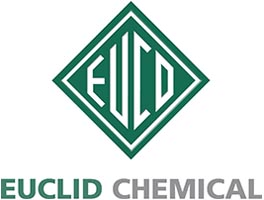 Euclid Chemical, a leading manufacturer of concrete and masonry construction products, has announced the opening of a new admixture plant in Calgary, Alberta. This facility will enable the company to better serve its customers in the region by providing high-quality admixture solutions that meet their needs.
Euclid Chemical, a leading manufacturer of concrete and masonry construction products, has announced the opening of a new admixture plant in Calgary, Alberta. This facility will enable the company to better serve its customers in the region by providing high-quality admixture solutions that meet their needs.
Positioned in a prime location with access to nearby railways and major transportation routes, this newly established facility ensures quick and efficient product delivery throughout the area. The Calgary plant will improve overall service levels by reducing lead times and ultimately delivering a better customer experience.
The newly operational facility is equipped with the latest equipment and technology, including advanced mixing and batching systems that provide accurate and consistent dosing of admixture ingredients. Euclid Chemical’s team of skilled and experienced on-site technicians operate the plant and confirm that every batch of admixture meets strict quality standards before being shipped to customers.
“The Calgary plant represents a significant step forward in our journey to enhance customer satisfaction and meet the growing demand in Canada,” said Thomas Gairing, president of Euclid Chemical. “We are committed to providing quality products and services while constantly improving our operations and capabilities to better serve our customers.”
To view the plant’s visual assets, visit https://bit.ly/3qy4BzT.
SCC Adds Program to Assist Industry
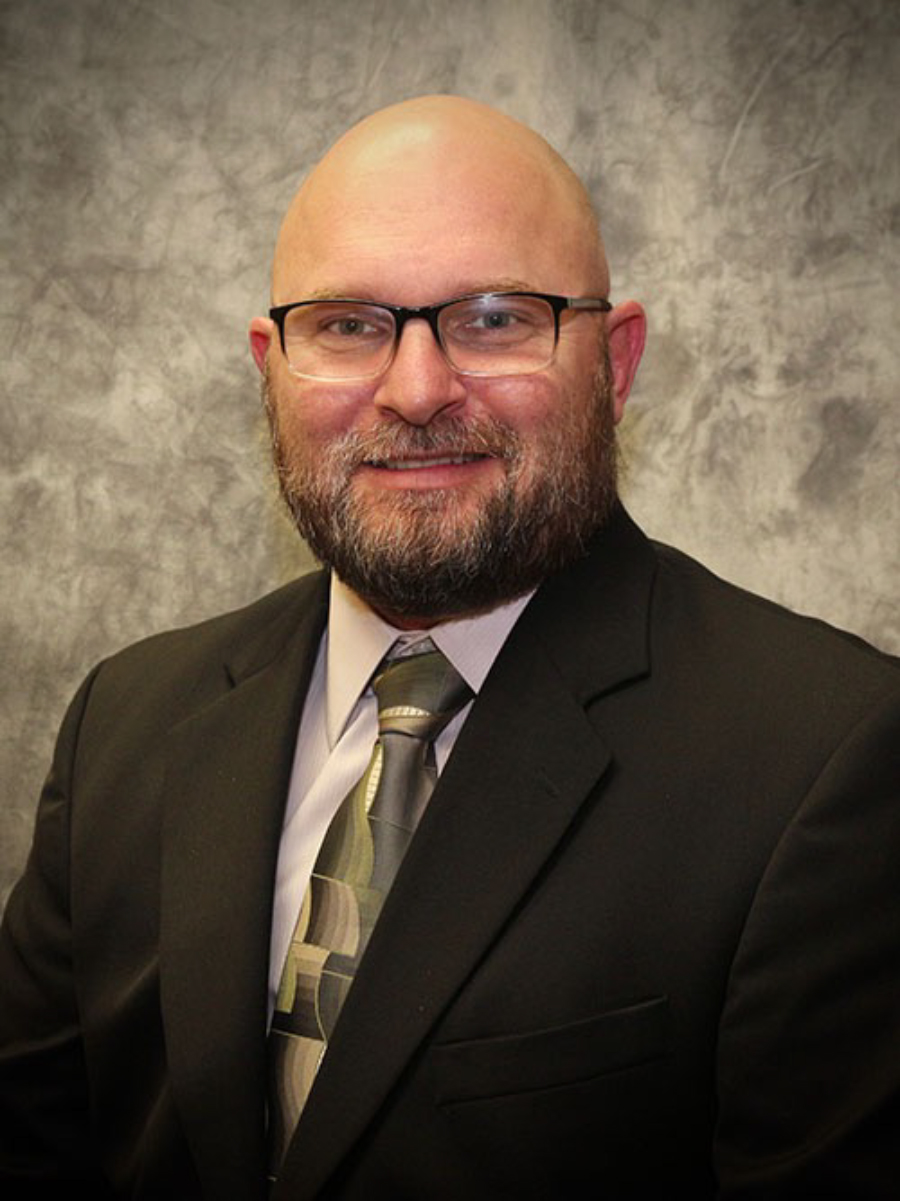 Career/technical programs at Southeast Community College strive to meet the needs of industry, and one of the latest additions is Concrete Construction Technician.
Career/technical programs at Southeast Community College strive to meet the needs of industry, and one of the latest additions is Concrete Construction Technician.
Students who successfully complete the program, located on the Milford Campus, will have a thorough knowledge and skillset related to project site preparation and safety; concrete forming, placing and finishing operations for vertical and horizontal concrete construction; mix design; and troubleshooting. They also will learn drafting and estimating skills.
Jereme Montgomery, who works in business development for Stephens & Smith Construction in Lincoln, said SCC’s program is unique to the state of Nebraska.
“I don’t know of any school in America that offers a Certificate, Diploma and Associate degree in Concrete Construction,” Montgomery said. “This program is unique.”
Montgomery also is a member of the program’s Workforce Leadership Team, comprised of representatives from industry who are focused on ensuring that program curriculum aligns with industry standards.
“The biggest benefit to this new program is that it creates a pathway for students to formally learn skills needed in the concrete industry,” Montgomery said.
Students will participate in program activities and projects affiliated with the American Concrete Institute, Nebraska Concrete and Aggregate Association, National Association of Home Builders, and the Associated General Contractors professional groups. Students will perform live concrete construction tasks throughout the year in the community, giving them valuable hands-on experience working with a wide array of variables.
Graduates can expect to find jobs that include concrete/masonry specialist, construction laborer, construction owner, project foreman, and as a skilled laborer.
“Depending on who you may talk to, there has always been a shortage of people in the concrete industry,” Montgomery said. “This problem was amplified during the 2008 recession when we saw the lowest numbers of construction employees in 2011. Even though the concrete construction industry has increased its workforce since then, we are still in need of a skilled workforce.”
SCC’s program is designed for a variety of students, including those who just want to get a feel for the program. The Certificate is 14 credit hours and extends to the 26-hour Diploma. The Associate of Applied Science degree is 60 credit hours.
“The biggest incentives to enroll in the program are the opportunities that it provides,” Montgomery said. “There will be plenty of scholarships and industry support for those who pursue this pathway. The concrete industry is hungry for new talent.”
Learn more at www.southeast.edu/concrete-construction.
Western Forms Receives Award Recognition
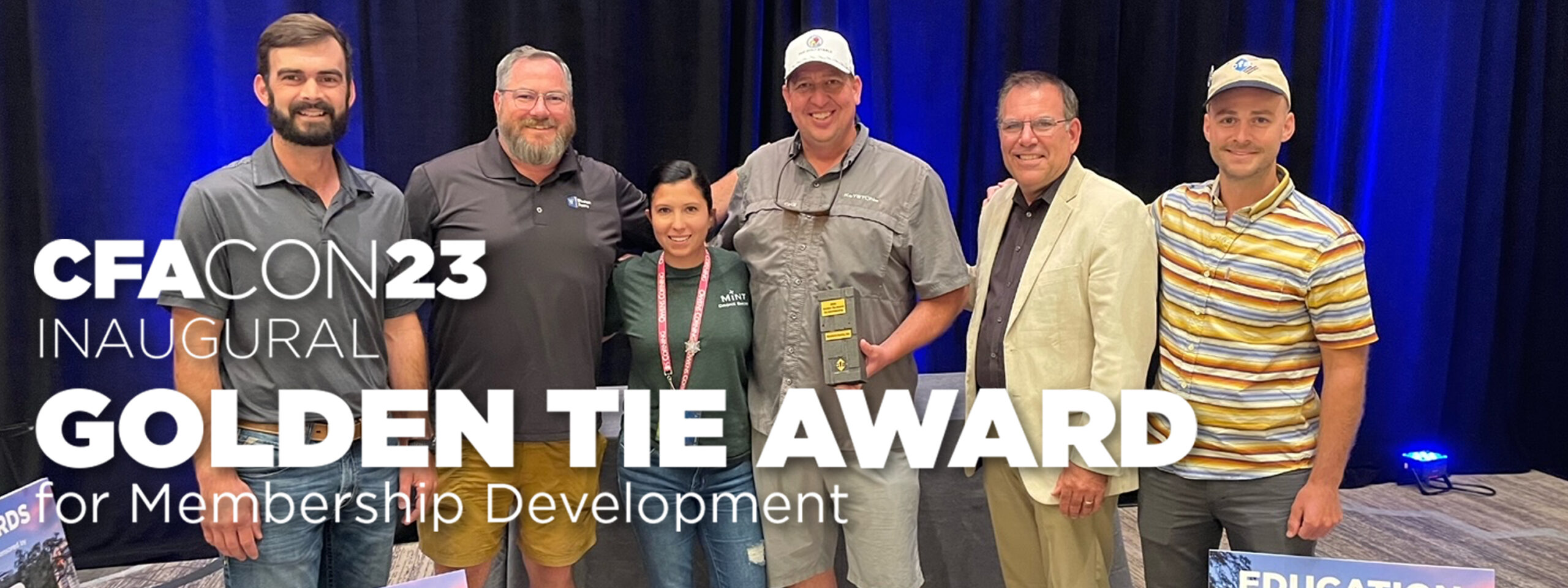 Want to know more, contact Skye Kelley at skelley@cfaconcretepros.org.
Want to know more, contact Skye Kelley at skelley@cfaconcretepros.org.
Calcium Chloride: Friend or Foe?
Many of the technical issues reported on in the residential concrete foundation industry are the result of questions or situations brought to the technical staff of the Concrete Foundations Association. The original content of this article is one such example, updated with additional information as you prepare for the 2023-24 winter season.
Situation: During a winter placement a couple of weeks ago, freezing temperatures were forecast so we requested the addition of 2% calcium chloride to the mixture at the batch plant for our early morning placement. It was very difficult for our crews to pour and put extreme pressure on the conveyor, the workers and the ready mix company. We had additional labor on the job, extra vibrators, and we still ended up with significant honeycombing.
Thoughts: Over the more than thirty years I’ve been working with concrete, the use of Calcium Chloride (CaCl2) has perhaps been the most common decision made by contractors and producers to get concrete to an early age maturity capable of withstanding freezing temperatures. After all, why shouldn’t this admixture be considered as, like Portland cement, calcium chloride reacts with water in a chemical reaction known as exothermal, which means the resulting byproduct is heat. Goals are set to elevate or simply maintain the concrete temperature with decisions that impact the mixture, the timing or external systems, countering the radiant loss of heat to the surrounding air.
As air temperatures drop, protecting the internal temperature of the concrete is your primary responsibility. In the traditional cold weather regions, contractors and producers begin with heating aggregate and using hot water. The next decision, and often the first in markets where heating systems are not common or available, is the addition of an accelerating admixture. Historically, when this decision has been made in the concrete foundation industry, calcium chloride has been the go-to product. As reported in CFA’s Cold Weather Research Report from 2004, “consider the use of small doses as it gives you the best bang for your buck.” However, in today’s market where all concrete walls are required to have at least temperature and continuity reinforcement, unless replacing an alternative to steel, calcium chloride is significantly restricted by code. The use of non-chloride accelerators have become the preferred solution, yet calcium chloride remains in the conversation.
This project exposes one of the most common problems in the use of calcium chloride, the impact of heated water in combination with the accelerating admixture. A minimum concrete delivery temperature is normally specified during cold weather placements. When considering the addition of an accelerator, the starting temperature point of the concrete batch is critical to monitor, particularly at the start of the day. Early in the day is readily known as the best time to place concrete during cold weather. You gain the added benefit of the entire day’s solar exposure to bring extra energy to the concrete mass as well as likely realizing the maximum daily temperatures. However, early in the morning, the aggregate, cement, and water temperatures at the plant are at their highest. They have been heated overnight with systems prepared for heating incremental use throughout the day and it is not surprising to see mix components much higher than the target batch temperatures. As the calcium chloride reacts to already elevated batch temperatures, the concrete temperature elevates in a semi-controlled setting resulting in accelerating the set and consuming water.
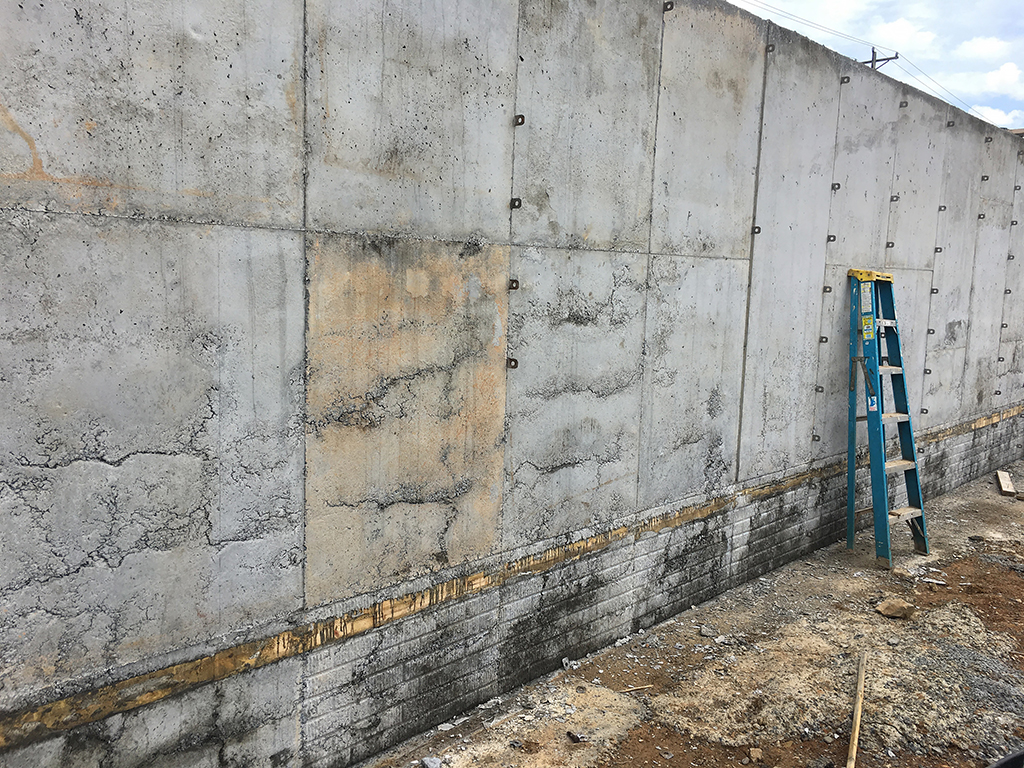 Further complicating the issue is the requirement for calcium chloride to be mae water-soluble before mixing. Assuming a target batch temperature of say 85 degrees F, adding the water-soluble calcium chloride to the mix immediately kicks the accelerator into action. The mix is then loaded into the drum and transported to the site. Drive times in most markets today are not uncommon between 30 to 60 minutes or more and at those temperatures, the concrete will begin rapidly hydrating. During this initial start of hydration, significant moisture is consumed resulting in a placement slump far below the expectation of the team. Knowing that an addition of water to reconstitute the slump beyond the designed w/cm is not possible, this leaves the contractor with few options. When determined to go through with it without adding more cost for a water-reducing admixture, the impact is most often realized in the finished concrete surface in the form of honeycombing as well as the very challenging placement efforts described by the contractor.
Further complicating the issue is the requirement for calcium chloride to be mae water-soluble before mixing. Assuming a target batch temperature of say 85 degrees F, adding the water-soluble calcium chloride to the mix immediately kicks the accelerator into action. The mix is then loaded into the drum and transported to the site. Drive times in most markets today are not uncommon between 30 to 60 minutes or more and at those temperatures, the concrete will begin rapidly hydrating. During this initial start of hydration, significant moisture is consumed resulting in a placement slump far below the expectation of the team. Knowing that an addition of water to reconstitute the slump beyond the designed w/cm is not possible, this leaves the contractor with few options. When determined to go through with it without adding more cost for a water-reducing admixture, the impact is most often realized in the finished concrete surface in the form of honeycombing as well as the very challenging placement efforts described by the contractor.
One the best alternative decision the contractor might consider is the jobsite addition of the calcium chloride. This product must be converted from its bulk flake to water-soluble in buckets before addition to the mix and this can be planned easily at the site. Once added and mixed thoroughly through the required resolutions of the drum, the concrete can be placed at a slump much closer to anticipated and the result will be far less risk of a stiff mix and resulting aesthetic imperfections.
Contractors need to be proactive and not reactive on this topic and evaluate the performance of your current mixes. As recommended in that same cold weather report, another great decision is investing in a maturity meter system as it is the fastest and most effective way to evaluate. Real time concrete temperatures are recorded and reported and when a drop in performance due to lower temperatures is realized, small changes can be made to tweak performance, one change at a time.
It is worth repeating that when using steel reinforcement, a proper reaction to this issue is to abstain from using calcium chloride altogether. While it is certainly stated in both ACI 318 and ACI 332 that calcium chloride is not to be used for structurally reinforced concrete that is not dry in service, its use in all other concrete applications is certainly permitted. The alternative would be a non-chloride accelerator (NCA) or a combination of higher strength mixes with Type III cement. Caution needs to be applied to both of these selections as there is research out there suggesting much lower hydration temperatures for NCAs than anticipated and Type III cements are often difficult to find in markets as well as having other use problems.
The best solution is to know your admixtures, develop a good relationship with your selected producer and plan the timing of the products to maximize their performance and prevent adverse problems.
For more information on this topic, contact the Concrete Foundations Association at info@cfaconcretepros.org or visit our websites, www.cfaconcretepros.org and www.concretefactsmagazine.com for more information.
Building Careers CFA’s Wall Foreman Qualification @ WOC2024
This January we welcome year number two of an exciting new professional development program offered by the Concrete Foundations Association: the Wall Foreman Qualification Industry Training. The program has expanded and looks to provide an even broader range of learning experiences. This program is designed for individuals engaged in residential cast-in-place construction to grow in their proficiency as leaders and craftspersons and advance in their careers. In combination with ACI/CFA Residential Foundation Technician Certification, the Wall Foreman Qualification program was designed to elevate this key position in the residential construction industry.
Last year, sixteen individuals completed the work to obtain a certificate as a residential wall foreman. These individuals, supported by their companies, attended six hours of industry training sponsored by the CFA in addition to another six hours (minimum) of electives taken from pre-approved courses throughout the World of Concrete education matrix.
A Wall Foreman is described by the Concrete Foundations Association as the primary representative of the company for jobsite operations. Responsibilities include working with (or serving as) the project manager for residential foundation installations; directing all field crews from excavation through final site work (as applicable); managing material application, security, and efficiency; implementing and maintaining safety operations; overseeing on-site equipment and operators; serving as Competent Person on site for safety programming; and managing training operations for workforce development.
This program’s goal is to present a consistent set of courses through national education programs, including the World of Concrete, Concrete Foundations Convention, and virtual Learning Management Systems, that provide quality professional development learning opportunities for the broad needs of the residential concrete industry. Additionally, the CFA looks to inspire the current and future generations of company owners to invest in their workforces through these opportunities.
During the World of Concrete 2024, the Wall Foreman Qualifications Certificate will once again be made available to registrants who achieve a total of 12 hours of qualifying education as selected and authorized by the CFA in consort with World of Concrete. Attendees registering for qualifying education during WOC2024 will be required to take six hours of specific residential concrete construction courses presented by industry experts on Thursday, January 25. The three required courses are described below. In addition, attendees seeking this qualification will select their remaining six hours of education from a pre-approved list of WOC seminars, including the optional four-hour ACI/CFA Residential Foundation Technician seminar. (The written exam is not required unless a candidate is seeking full certification.)
How do you register yourself or your rising workers for this opportunity?
Step 1: REGISTRATION. Available only through WOC2024. To access the discount code from the CFA Co-Sponsorship, use custom link https://www.compusystems.com/servlet/ar?evt_uid=130&promocode=A30. Note: The CFA Co-Sponsorship code includes discounted $25 for WOC Exhibits Only admission if you register by 12/15/2023.
Step 2: EDUCATION OFFERINGS. Sign up for the three industry training courses presented by the CFA on Thursday: CFA1 – “Concrete Basics that Impact the Residential Concrete Industry,” CFA2 – “Residential Wall Forming and Reinforcement Best Practices,” and CFA3 – “Solving the Problems of Residential Foundations.”
Step 3: ELECTIVES. Select a minimum of six additional hours from the World of Concrete education matrix between Monday and Wednesday of WOC2024 week. One of the options is TU406 – “Residential Foundations: Compliance and Competency Review.” Additional course codes pre-approved by the CFA for qualification are: MO01, MO02, MO102, MO103, MO11, MO110, MO111, MO112, MO119, MO120, MO121, MO128, TU03, MO07, TU08, TU104, TU105, TU114, TU122, TU13, TU133, TUCSW, TUFF02, TUFF03, WE04, MO06, MO101, WE107, MO12, MO401, MOTRW, WE115, TUFPT, TUSTS1 WE116, WE144, MO129, MO131, WESTS2, MOSP101, TUSP03, TUSP04, WESP05.
The last four codes, those with “SP” in them, are pre-approved courses presented in Spanish.
A robust variety of leadership-focused, technical, general business, hands-on training, and material science courses has been selected; each course works toward training a well-rounded wall foreman for your company. How will you continue to establish or advance your market leadership?

Let’s Take a Look at Recruiting From a Different Perspective
There is an advantage to driving on the other side of the road in South Africa. Likewise, there is an advantage to driving at night with a cellphone GPS that takes you through sketchy neighborhoods on the way to your hotel. The advantage is that you see things from a different perspective. This new perspective is further enhanced with the addition of a couple of safaris—you really get to see the world differently.
Most hiring managers and companies look at recruiting from a desperate perspective – “I need Dependable Workers who can do the job now!” This is their perspective, and it is understandable. They have a project with deadlines. They cannot delay the finish, or if they do, there may be penalties.
Who thinks about the candidate’s perspective? Isn’t this an equation? Doesn’t the recruiting process require a win for both sides?
Some managers blow through employees. What is the impact of this practice on your concrete business? You constantly need to hire new, probably mostly untrained (for your business) employees – only to hear from the manager that they are not performing to the manager’s standards.
Would a better method be to attract candidates who want to learn about your concrete business? Talent Attraction is better than Talent Acquisition.
Talent Attraction requires that you accept your needs and accept and embrace the needs of your candidates and employees.
 Concrete and Psychology Do Mix
Concrete and Psychology Do Mix
Every successful business effectively uses psychology. Some companies are more aware of it and more successful than others. The focus here is on psychology regarding your employees (your business may also employ psychological fundamentals with your clients).
According to psychologist A.H. Maslow’s hierarchy of needs, humans have physiological needs, including food, water, air, exercise, and biological drives that keep the body functioning at a high level.
The environmental needs include a safe and secure place to live. An environment that is free of psychological assault, including name-calling, public embarrassment, and passive-aggressive assaults (nice to their face but rude behind their back).
The growth needs pertain to how humans like to learn new things. Physically, in concrete work, they may not be able to exercise their new learning, but they may develop insights to help your business be more effective. Our nature is complicated. On the one hand, we resist change (even in changing jobs). On the other hand, we thrive by learning new ways to implement our training.
Our emotional needs include the feeling of belonging. You may begin to cultivate a culture of belonging with the simple practice of giving company t-shirts in the summer and company sweatshirts for the cooler months, identifying them as members of your concrete team. This action also provides your company with advertising when employees go to lunch.
We all have self-activation needs. Everyone loves to solve problems – and to be recognized for doing so. We love spontaneity (appropriate humor is an example, and even better is unexpected praise).
When I worked for a general contractor for several years, after starting as a job clerk, I was promoted to assistant project manager (I assisted with estimates and bidding). Then I worked with a second general contractor as a finish superintendent before being promoted to construction superintendent. I intuitively followed these principles (I studied psychology for two years). I retained my laborers because I was loyal to them, and I only corrected them in private (unless there was an immediate safety issue).
You may address these needs in your interview process by adding questions that pertain to them. Remember that laborers most likely have not studied A.H. Maslow, including many workers with college degrees.
Sample questions include:
What do you feel that you will like the most about working with our concrete company? Their response will tell you about their motivation (or lack of it).
What did you like in your last job? This response informs you how to motivate them.
What drove you crazy at your last job? Now you know what your managers need to avoid.
 Editor’s note: Bill Humbert, RecruiterGuy.com, is a consultant member of the Concrete Foundations Association. He offers these quarterly articles as a way of inspiring workers in this industry to think more strategically and creatively about the talent attraction and retention processes. As valuable as this free advice found in Concrete Facts is, how much more could you and your company benefit from becoming a member of the Association? How much more could you benefit from a work session or two with RecruiterGuy? You may reach out to Bill directly to set up an appointment (www.recruiterguy.com/contact/).
Editor’s note: Bill Humbert, RecruiterGuy.com, is a consultant member of the Concrete Foundations Association. He offers these quarterly articles as a way of inspiring workers in this industry to think more strategically and creatively about the talent attraction and retention processes. As valuable as this free advice found in Concrete Facts is, how much more could you and your company benefit from becoming a member of the Association? How much more could you benefit from a work session or two with RecruiterGuy? You may reach out to Bill directly to set up an appointment (www.recruiterguy.com/contact/).
Fiber-Reinforced Concrete as an Alternative to Conventional Steel
As the demand for more sustainable construction grows and raw material shortages like steel continue to be a challenge, fiber-reinforced concrete has become an increasingly popular choice for flatwork and elevated construction—from precast and ready-mix concrete to shotcrete.
Fibers make concrete significantly more resistant to cracking from plastic and drying shrinkage, leading to a highly durable end product with a longer lifespan. Some fiber types can even greatly reduce construction time and, in some applications, eliminate the need for conventional steel.
Why Use Fibers in Concrete?
- Regarded as a cost-effective, durable and even sustainable alternative to conventional steel like rebar and wire mesh, fiber-reinforced concrete boasts a variety of benefits:
- Prevents plastic and drying shrinkage cracks
- Enables faster construction times and lower labor costs
- Finishes smoothly with any surface fibers quickly fading under foot/vehicle traffic
- Provides same level of reinforcement as wire mesh with even distribution throughout concrete
- Eliminates the need for chairs to support conventional steel rebar and wire mesh
- Well recognized by major concrete organizations and tested to industry standards
How Synthetic Fibers Compare to Steel
While micro-synthetic fibers provide superior resistance to plastic shrinkage cracking over welded wire, they aren’t resistant to further crack width openings caused by drying shrinkage, structural load or other forms of stress. However, they should be regularly specified in any concrete type to improve cracking resistance, spall protection, freeze-thaw durability and homogeneity of concrete during placement. Microfibers are available in ½” – ¾” (12 – 19 mm) lengths, with dosage rates varying from 0.5 – 1.5 lbs/yd3 (0.3 – 0.9 kg/m3) depending on the fiber product and application type.
Macro-synthetic fibers not only provide resistance to plastic shrinkage but also enhance concrete’s durability, toughness and limited structural capacity when properly designed. Dosed at amounts equivalent to conventional reinforcement, these fibers are distributed three dimensionally throughout the concrete section. Macro-synthetic fibers can be likened to the use of steel fibers, but are usually easier to place and finish due to their lighter weight, non-corrosive nature and high pumpability. Macrofibers are typically 1 ½” – 2” (38 – 50 mm) in length, with dosage rates varying from 3.0 – 15 lbs/yd3 (1.8 – 9.0 kg/m3) depending on the fiber product and application type.

Micro-fiber reinforcement used to control shrinkage cracking of plastic concrete
So, can synthetic fibers compete “head-to-head” with steel? Absolutely! Macrofibers offer durability and residual strength capacity equivalent to steel. Assuming an adequate fiber design is performed, macro-synthetic fibers generally require 5-10 times less weight of material compared to steel, streamlining on-site handling and storage. They are also non-magnetic and non-corrosive, making them ideal for exterior pavements where aesthetics and safety are a concern. Since concrete containing macrofibers is mixed, the fiber also becomes somewhat pliable and not nearly as abrasive to pumping lines and equipment.

Synthetic macrofiber reinforcement
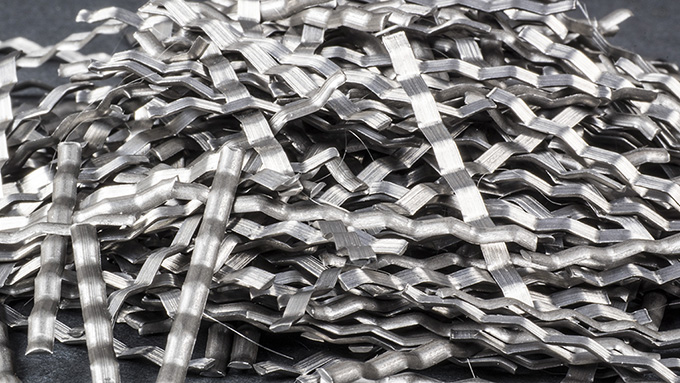
Typical steel fiber reinforcement
CONCRETE FLOORING
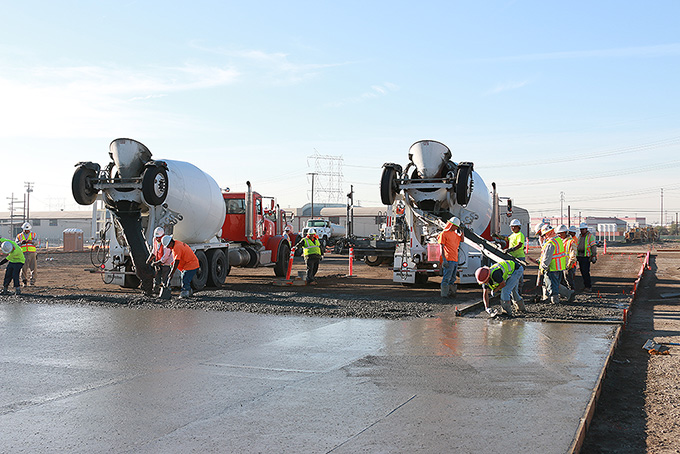
Macrofiber reinforcement provides cost savings over rebar and welded wire
Providing concrete floors with early-age cracking resistance, fiber reinforcement can be used to replace conventional steel for temperature/shrinkage crack control and limited structural applications. The three-dimensional reinforcement offered by macrofibers also offers greater abrasion, fatigue and impact resistance while increasing service life through enhanced durability.

Macrofiber provides three-dimensional reinforcement against cracking
Additionally, the concrete matrix’s increased tensile capacity can reduce overall shrinkage stresses, which allows for increased joint spacing. There are successful examples and significant industry research that support the increase of control joint spacing in floor designs with macro-synthetic and steel fibers. This is typically combined with improved concrete mix designs using advanced chemical admixtures as well as proper placement and curing practices.
Some fiber manufacturers have also experimented with joint-free floors. To extend joint spacing beyond traditional construction practices, there are many factors that must be considered. Low water-to-cement ratio, lower cement content, and shrinkage reducing and/or compensating admixtures with adequate curing yields strong durability with reduced risk for curling and shrinkage cracks. Other factors such as proper subgrade preparation, placement, saw-cut depth, curing time and exposure conditions must also be evaluated.
It is highly recommended to conduct testing and verification prior to a flooring construction project to ensure engineering and specification requirements are met. This is typically done by conducting shrinkage tests on the proposed concrete mix design to establish general shrinkage characteristics, which lead to the discussion of potential joint spacing measurements.
CONCRETE PAVEMENT
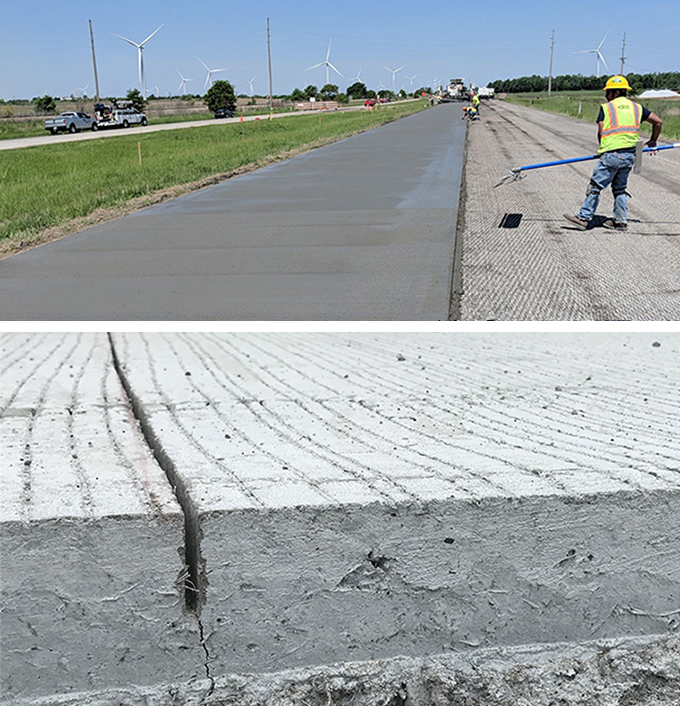
Concrete pavement with macro-fiber reinforcement
Fiber-reinforced concrete is also a cost-effective, sustainable solution for resurfacing and rehabilitating existing pavements and bridge decks. In fact, many state DOTs and other transportation agencies are promoting macrofibers over conventional steel and developing performance-based specifications for pavement overlays and full-depth replacement systems to increase service life and reduce long-term maintenance costs.
Macro-synthetic fibers significantly reduce or even completely eliminate the expense and installation time of conventional reinforcement, while producing concrete pavements that are easily placed with less environmental impact on the jobsite.
CONCRETE WALL SYSTEMS
Macro-synthetic fibers can also be used as an alternative to steel reinforcement with nearly any concrete wall application. The dosage rates are based on strength-to-strength calculations supported by standardized test methods and industry practices. This significantly reduces time and labor costs, while producing more durable concrete. These fibers can also provide the same strength capacity as steel in wall applications such as foundations and retaining walls.
Macro-fiber reinforcement can be used as a cost-effective, sustainable solution for buildings constructed with insulated concrete form (ICF) wall systems, which have historically been reinforced by steel rebar engineered to resist forces from soil, wind and other loading conditions. Dosed correctly, macrofibers eliminate rebar in ICF walls for significant time and cost savings.
Considerations for Concrete Mix Design & Application
Adding fibers often reduces the slump of a concrete mix, which measures the workability of fresh concrete during placement. This is likened to adding more ingredients to the mix and, therefore, requires more fluid to maintain an apparent slump—hence the appearance of workability loss. Microfibers, used at typical dosages, generally only decrease slump slightly and don’t require significant changes to maintain placement characteristics. Yet, macro-synthetic and steel fibers can affect the workability of concrete in a more significant way, depending on fiber type and dosage.
To improve the workability of fiber-reinforced concrete, the ACI 544.3 standard offers recommendations and guidance to potentially modify the mix design. Additionally, the use of chemical admixtures like superplasticizers or water reducers increase the workability of concrete without adding water. It is recommended that trial batches are performed to ensure mixture workability.
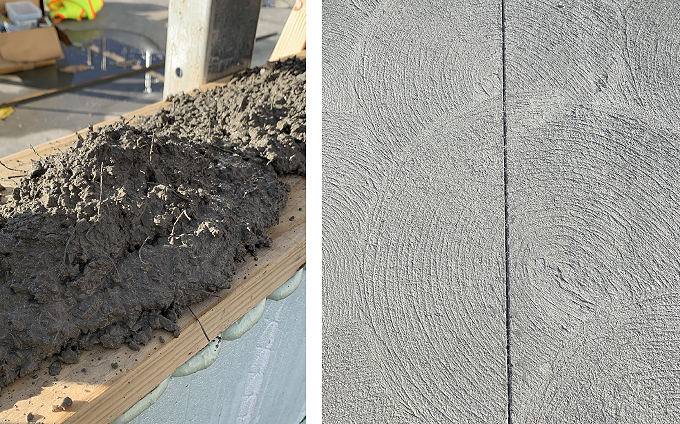
Fiber used insulated concrete form construction / Typical fiber-reinforced concrete surface finish
Factors such as fiber material type, architecture, dimension and dosage may affect the surface finish of fiber-reinforced concrete, as well as the required surface-finishing method that is used. Stiff or rigid fibers typically have a greater tendency to protrude up through the slab than flexible fibers.
Proper external vibration is another key factor when finishing fiber-reinforced concrete. The general recommendation is to use the same finishing techniques and approximate timing as conventional concrete. When casting samples for testing, no internal vibration within the molds can be used. Synthetic fibers may delay bleed water at the surface, which impacts finish timing on larger slabs.

Broom finishing macrofiber-reinforced concrete
There are many broom finishing tips that minimize surface appearance, such as brooming in one direction or using specific broom bristles to align surface fibers. If necessary, a torch can burn off synthetic fibers on a concrete surface—but should not be used until all desired hardened concrete properties are achieved. When finishing industrial, commercial and warehouse floors where high dosage levels of macro-synthetic and steel fibers are used, a laser or vibrating screed is usually recommended.
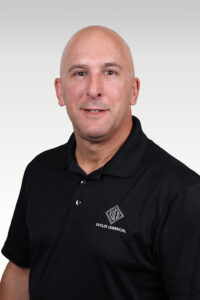 Michael Mahoney is a professional engineer and director of marketing and technology for fiber-reinforced concrete at Euclid Chemical. He is a fellow and member of the American Concrete Institute and has served on various committees for the National Pre-Cast Concrete Association and American Society for Testing and Materials. To learn more, visit www.euclidchemical.com.
Michael Mahoney is a professional engineer and director of marketing and technology for fiber-reinforced concrete at Euclid Chemical. He is a fellow and member of the American Concrete Institute and has served on various committees for the National Pre-Cast Concrete Association and American Society for Testing and Materials. To learn more, visit www.euclidchemical.com.
El liderazgo autodefinido proviene de tomar riesgos
English | Translation Provided by the CFA
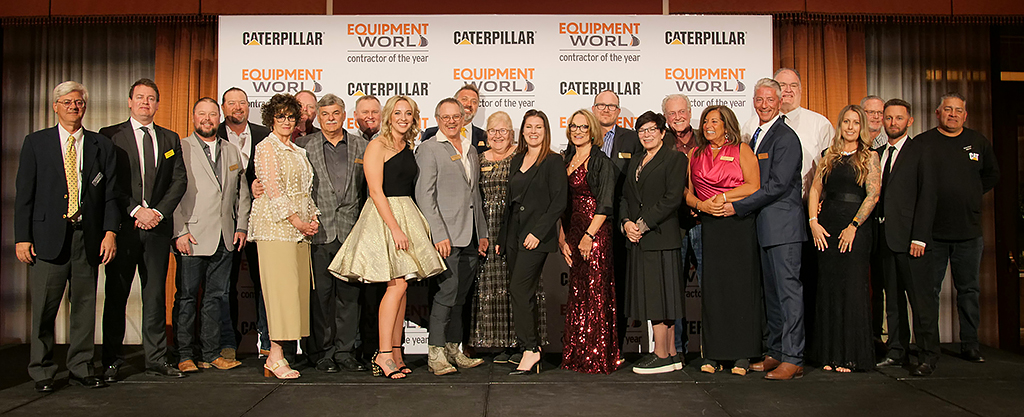
Skye Kelley, Gerente de Participación de la Membresía
Una entrevista con Amanda Kurt, finalista de Contratista del Año de 2023 de Equipment World
Las mejores asociaciones incluyen una amplia variedad de miembros. Esta diversidad alimenta el pensamiento variado y desafía el crecimiento de la industria. Sin embargo, en la superficie de la industria del concreto, la diversidad puede ser difícil de percibir e incluso más difícil puede ser el cumplimiento con la equidad. No obstante, si uno retira las capas externas o atraviesa el exterior endurecido, existe una cultura rica y vasta de éxitos en el mundo del concreto. No obstante, este éxito diverso y equitativo no es natural ni se produce con facilidad. A medida que iniciamos el año 2023, una historia de este tipo de éxito comenzó para Amanda y John Kurt, Vicepresidenta y Socia Administrativa de Kurk Inc. en Union Grove, Wisconsin. Hablé con Amanda Kurt para escuchar sobre el reto que ella enfrentó, un reto que ahora ella lanza a sus pares en toda esta industria.
Esta historia comenzó hace más de una década con un dúo de padre e hija que examinaban el futuro del negocio familiar. Después de obtener un diploma en ingeniería, Amanda regresó a casa para seguir su pasión por el concreto que le fue transmitida a una edad temprana. Ella y su padre, John, rápidamente vieron grandes oportunidades. Amanda comenzó a identificar algunos de los problemas que enfrentaría y descubrió el apoyo que sería fundamental para romper las suposiciones que rodean las normas culturales.
Le pregunté a Amanda, “usted es una pionera que no le teme a un reto y simplemente se pone en la línea de fuego. ¿Qué consejo tiene para otros que no están seguros de dónde encajan en esta industria?
Hace mucho tiempo alguien me dijo, “Debes llegar a las personas en donde se encuentren”. Para mí, si quería tener más personas en la construcción y más mujeres, debo presentarme en donde ellas están. ¡Creo que muchas personas no se dan cuenta de que ellas también pueden hacerlo! Es importante para mí involucrarme y demostrarles a las personas que son valiosas. Es lo que me impulsa a involucrarme con escuelas, organizaciones profesionales, mi comunidad, etc. Si puedes tener un impacto positivo en una sola persona, eso es suficiente.
El concreto es una industria de trabajo en equipo. Se debe confiar en la fortaleza de un equipo para obtener resultados de calidad. Esto significa que los líderes jóvenes, especialmente las mujeres, se encuentran trabajando para escuchar, relacionarse y hacerse valer sin distanciarse de otras personas. La estafeta simplemente no se pasa y de inmediato es reconocida por otros. La consistencia y la intencionalidad sientan la base de la confianza y el valor. Al preguntarse si considera que esto es cierto, Amanda respondió:
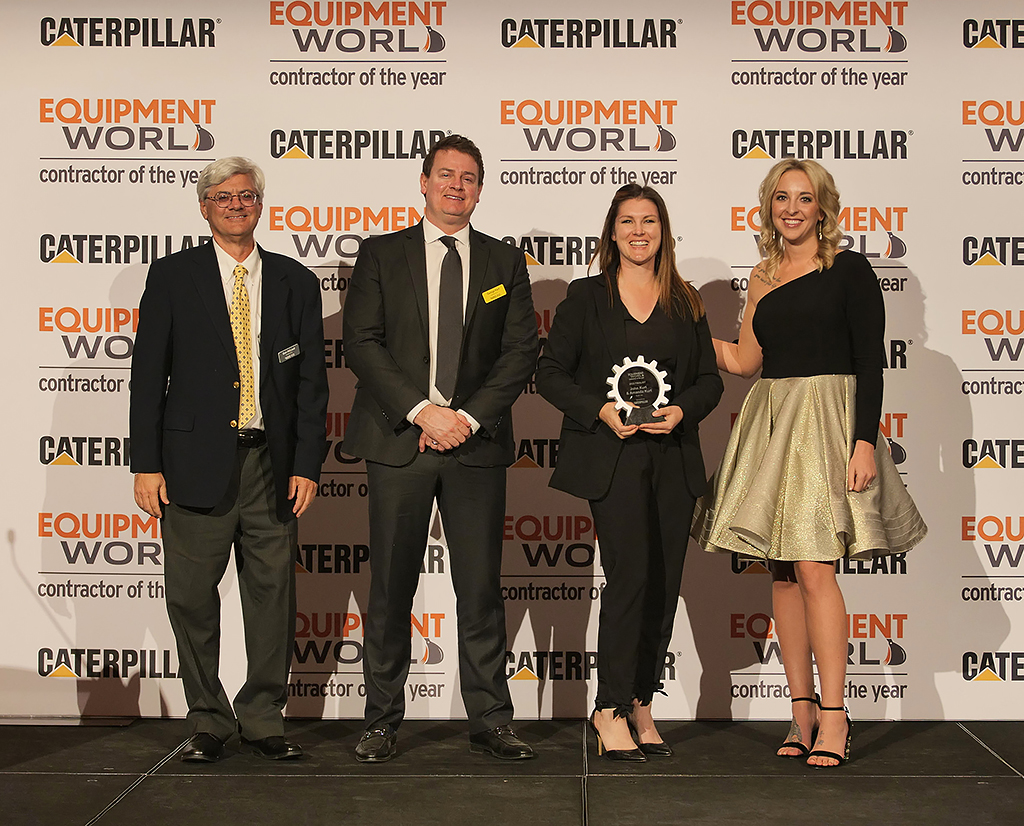
Parte de lo que aprendí en los últimos dos años es que debes tener una intención en el lugar donde quieres crear un impacto. Específicamente, para nosotros, nuestros empleados venían de un área geográfica específica y sus hijos estaban en la misma comunidad. Nos dimos cuenta de que era el distrito escolar y la comunidad en donde queríamos estar y tener contacto. ¡Ahí era donde estaba nuestra gente!
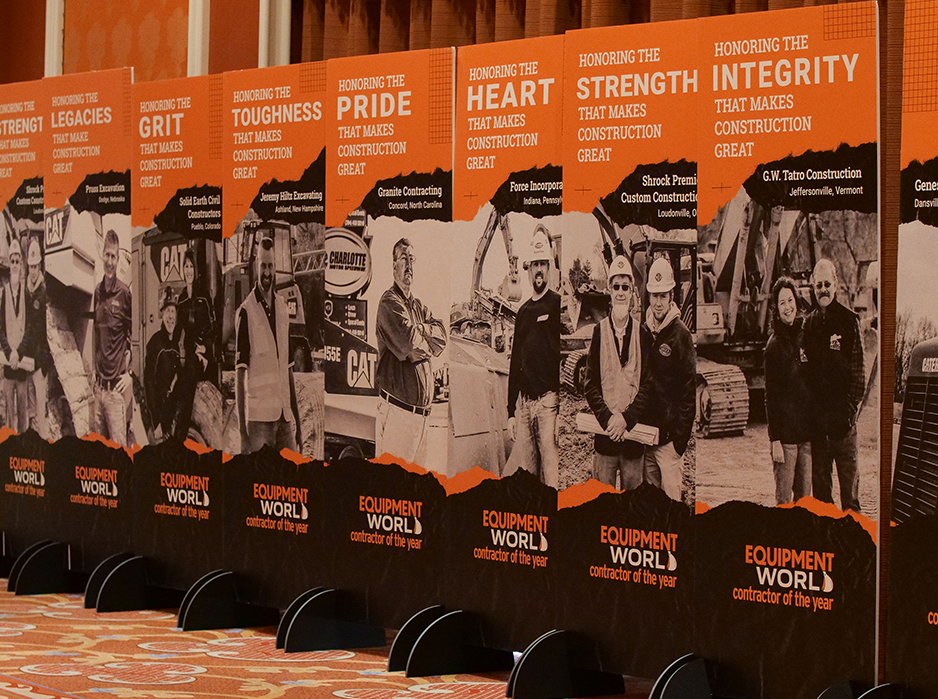
Saber que no siempre es fácil identificar o seguir este camino hacia el éxito, le pedí a Amanda que explicará más cómo llegó ahí y a lo que ella más atribuye su avance que otras personas también pueden identificar.
Específicamente necesitaba aconsejar directamente a las mujeres en la industria [del concreto]. Creo plenamente que necesitas un campeón hombre que apoye tu avance en la industria. Es algo excepcionalmente beneficioso. Esta industria es impulsada por hombres y sus raíces están orientadas hacia los hombres. Tener un campeón hombre puede ayudar a cerrar la brecha y apoyarte, especialmente cuando estás buscando consejos. Mi papá me convenció de que había un lugar para mí y di los primeros pasos. Lo más importante es que él les demostró a todos los que nos rodeaban que confiaba en mí, lo que reforzó mi objetivo y compromiso.
Una plataforma para el éxito como el que ha alcanzado Amanda al elegir el negocio familiar a menudo es suficiente para muchos. Confiar en una compañía que ya es exitosa y que pasa por varios momentos turbulentos recientes, como se pudo ver en las últimas décadas, puede ser muy gratificante. Sin embargo, para las mujeres, los roles, las metas y las responsabilidades más amplias definen la individualidad y requieren una flexibilidad y perseverancia excepcionales. Amanda ha desarrollado gradualmente su plataforma y ha respondido a los retos cada vez mayores que la vida le ha presentado. Su compañía continúa refinando sus procesos y mantiene un compromiso con desarrollar a su gente para ser las mejores versiones de ellos mismos. Su visión es continuar con su tendencia a la alza como líder en su área y mercado, el cual está principalmente arraigado en proyectos multifamiliares de construcción de concreto, que es su especialidad.
En mi investigación, he encontrado evidencia de la voz de Amanda en todas partes, así como una amplia variedad de actividades y compromisos. Sentí que debía pedirle que considerara esta lista parcial de ser socia en Kurk Concrete, madre y estar activamente involucrada en su comunidad local, así como también servir en el Comité Ejecutivo para el Cooperativo de Cuadrillas, y participar como miembro del Consejo Directivo de la CFA. Recientemente me enteré de que había sido seleccionada como conferencista en la ConExpo y había enviado temas para ser conferencista en World of Concrete. Así que, con toda esta experiencia, quise saber qué cree ella que le depara el futuro.
Personalmente, quiero averiguar si hay una manera de interactuar más con los niños y demostrarles que la construcción es una oportunidad para cualquier persona. A los 7 años, empiezas a eliminar carreras profesionales, típicamente es una decisión basada en el género. Por ejemplo, eres niño y decides que no puedes ser bailarina. Del mismo modo, eres niña y no ves chicas conduciendo camiones de volteado. Obviamente, los padres solo pueden mostrar a sus hijos ciertas cosas basadas comúnmente en lo que es visible a su alrededor. Sin ejemplos reales o una fácil visualización de una mujer que conduzca equipo pesado, ¿qué hacemos para evitar que las niñas descarten la construcción como carrera?
Agradezco la oportunidad de unirme al Consejo de la CFA. Es fácil identificar que cada miembro hombre del consejo de la CFA es campeón de alguien; realmente creo en eso. Son honestos y pensadores progresivos a quienes les apasiona mejorar la industria. Utilizan estas cualidades para volver y compartir o hablar a otros, motivándolos para que se unan al poder de las redes de contactos.
El Consejo Directivo de la CFA históricamente ha proporcionado una fuerte representación de liderazgo de ideas en esta industria. Está comprometido a ofrecer eventos con regularidad para establecer redes de contactos y asegurarse de que cada uno de los eventos sea una experiencia valiosa. Ya sea que se trate de una sesión educativa regional, una reunión del consejo o una convención anual, los miembros del consejo han mantenido el lema de predicar con el ejemplo. Fue apropiado y emocionante darse cuenta de que el riesgo que tomó Amanda durante el verano de 2022 es el mismo que tomó un miembro del Consejo de la CFA, Jeff O’Risky de O’Risky Excavating en Evansville, Indiana, hace un par de décadas. Este riesgo fue nominarse a sí misma como Contratista del Año de 2023 de Equipment World. Tuve que preguntarle cuál fue su interés en tomar ese tipo de riesgo.
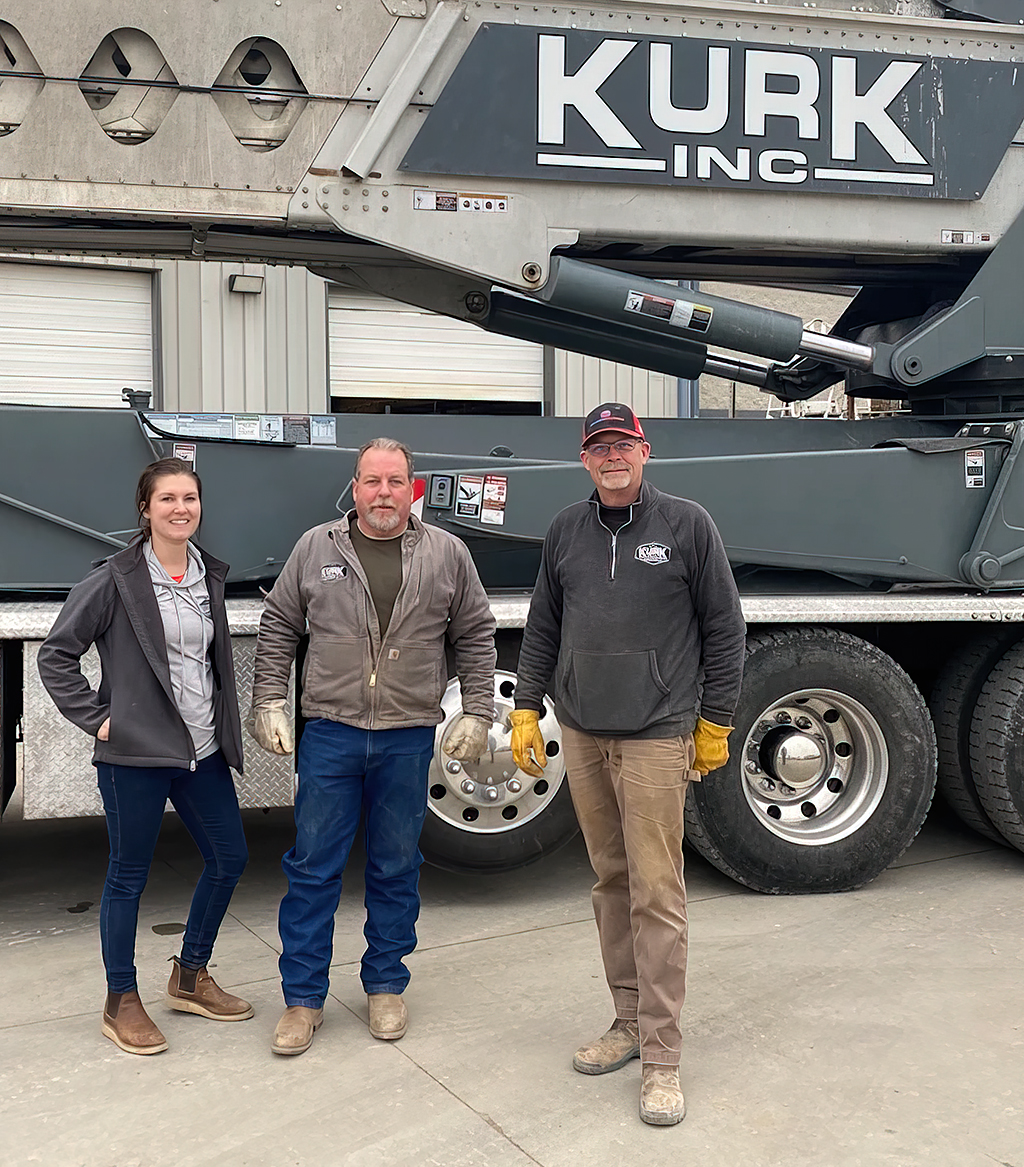
Nuestra compañía ha mantenido un interés en el ramo de equipos pesados de la industria. Al prepararnos para la Con Ag/Con Expo, me enteré sobre este reconocimiento, me pareció un programa increíble y estaba convencida de que seríamos ideales para él.
El Contratista del Año, establecido y organizado por Equipment World, la rama de medios de comunicación de Con Ag/Con Expo y una tienda importante para la industria de la maquinaria de la construcción, es un programa que busca destacar a algunos de los mejores ejemplos de las compañías de construcción en Norteamérica. Las nominaciones son enviadas principalmente por las propias compañías, para lo cual deben cumplir con un conjunto impresionante de calificaciones mínimas. Para comenzar, la compañía debe tener ingresos anuales de entre 3 y 15 millones de dólares, poder demostrar un récord de seguridad consistente y excelente, y ser propietaria de un mínimo de cinco máquinas de construcción con operadores a bordo. La persona nominada también debe tener al menos diez años de experiencia como propietaria de la compañía de construcción y ser capaz de representar a la industria de la construcción de una manera positiva. En 2023 había de 50 a 60 solicitantes de los cuales doce fueron seleccionados como finalistas para estar presentes durante el evento y la posible selección. Amanda fue uno de los doce finalistas en 2023 y veinte años antes, Jeff O’Risky fue finalista en 2003.
Durante la reunión del Consejo de la CFA en otoño de 2022 en Dallas, Texas, Jeff O’Risky dirigió la atención de todos hacia la selección de Amanda como finalista. Él se aseguró de que el resto de los contratistas reconocieran lo importante que era esto y animó a que la apoyaran para recibir el reconocimiento. Le pregunté a Amanda si ella sabía antes de su nominación y participación posterior que Jeff [O’Risky] había sido finalista y si fue así, ¿le proporcionó alguna guía o consejo?
¡No, un día recibí de la nada un mensaje de texto de él! No me había dado cuenta de que él también había sido finalista, pero me pareció muy amable de su parte que se comunicara conmigo. También creo que es increíble que ahora dos miembros del Consejo de la CFA hayan sido finalistas para Contratista del Año de este prestigioso premio, que tantos pensarían que está fuera de la experiencia o el enfoque.
Puesto que esta fue una experiencia significativa personal y profesional, quise saber más y le pregunté a Amanda, ¿cuál fue su mayor aprendizaje de esta experiencia?
Me pareció alentador saber que todos nosotros compartimos problemas similares. Los doce finalistas provienen de obras diferentes. Por ejemplo, escuchar a los excavadores y pavimentadores compartir sus retos con los que me podía identificar fue algo asombroso. Todos buscamos soluciones a los mismos problemas, pero de maneras diferentes. Escuchar qué están haciendo y cómo están enfrentando los retos fue muy estimulante. Tuve una conversación maravillosa con un finalista que era contratista de pavimento y descubrí cómo estaba desarrollando la comunidad dentro de su compañía. ¡De esta conversación me llevé algunos consejos y ya los estoy implementando en Kurt Concrete este año! Ya veremos cómo reacciona nuestro equipo.
Al querer saber un poco más, le pregunté cuál fue su momento favorito de su experiencia en Equipment World en Las Vegas.
Debe ser la interacción con Caterpillar. No solo patrocinaron la ceremonia de premios, sino también nos llevaron a hacer un recorrido VIP de su centro de exhibición. Fue realmente increíble interactuar con ellos y ver las innovaciones en las que están trabajando. Caterpillar está a la vanguardia de la industria y la tecnología; es una compañía progresiva. Su gente es impresionante, ¡simplemente entienden de todo!
Otro rasgo primordial o quizá una norma cultural de la industria de los contratistas es una resistencia al reconocimiento que viene de los programas de premios. Anualmente hay programas de premios significativos a través de diferentes organizaciones de la industria y medios de comunicación. La Concrete Foundations Association ofrece a sus miembros una competencia anual para exhibir construcciones desafiantes y de alta calidad —los Proyectos del Año— así como los premios de reconocimiento profesional para el Contratista del Año, Premio a la Innovación y un Premio de Liderazgo en Kick-Starter. El énfasis en la trayectoria profesional y el impacto a la industria se reconoce a través del Premio MVP, Premio a la Trayectoria Profesional y el prestigioso Premio Robert D. Sawyer. Es un desafío encontrar personas en general, mucho menos en esta industria, dispuestas a nominarse para los premios. Puesto que sabía el riesgo que tomaba, le pregunté a Amanda si hay algún consejo que le gustaría proporcionar a alguien que esté pensando en nominarse para este premio u otros similares.
Una de las preguntas de la solicitud era qué otros premios han ganado o si hay algún artículo publicado sobre usted. Creo que esto sería un reto para otros contratistas, especialmente para aquellos que no tienen un equipo de relaciones públicas o mercadotecnia. Las compañías corporativas más grandes tienden a tener todo un equipo a cargo de los medios de comunicación, pero las organizaciones más pequeñas normalmente no lo tienen. La realidad es que la mayoría de los premios que vemos que ganan las personas son los que requieren una autonominación. ¡Mi consejo es que se inscriban para el premio y se nominen ustedes mismos!
Amanda recomienda que en el mercado actual es necesario “contar su propia historia”. Si no lo hace, alguien más va a describir una versión de su historia en nombre suyo o van a aprovechar la oportunidad para crear una diferente ellos mismos.
Una manera es tener la confianza de ponerse en contacto con un periódico local y presumir humildemente el trabajo que está haciendo su compañía.
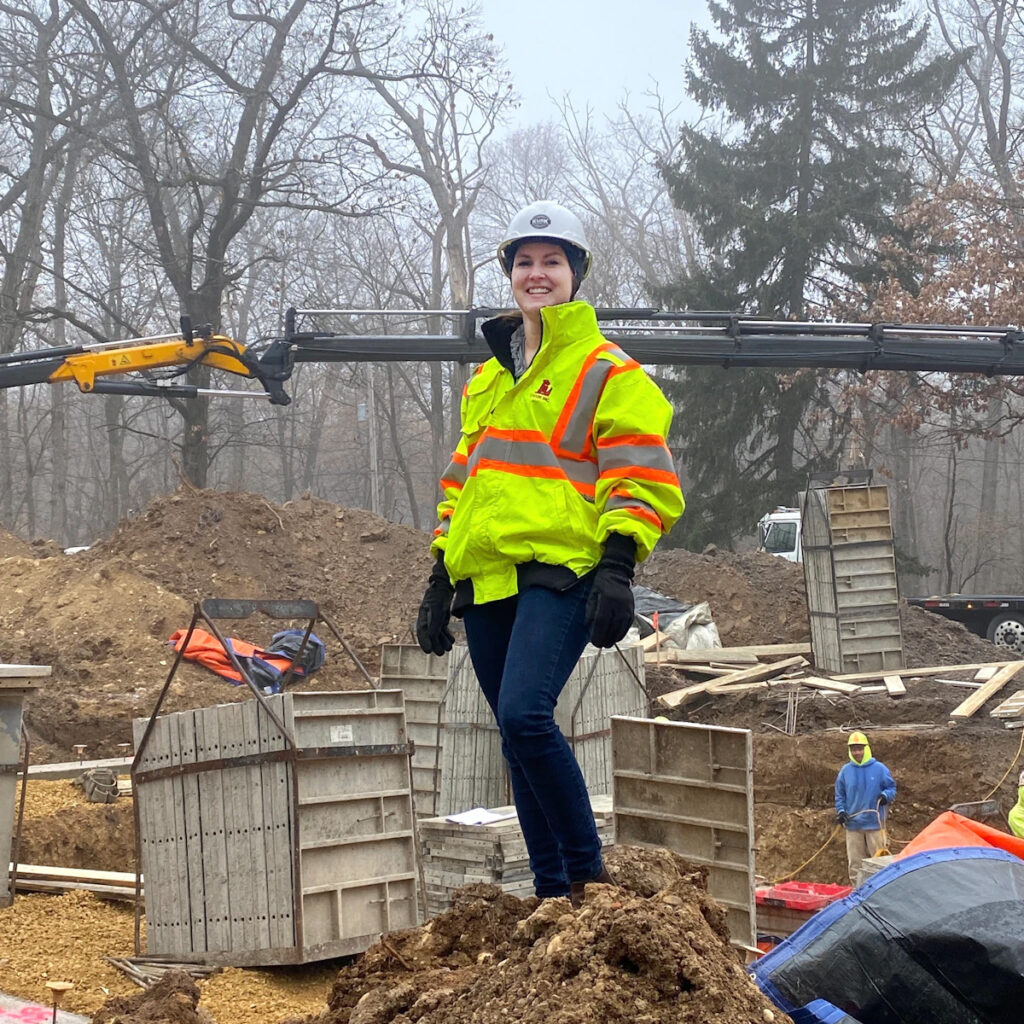
Cuando se trata de identificar cuáles historias contar, es especialmente importante describir los esfuerzos para los valores culturales o que no están relacionados con el negocio dentro de su mercado local. Además, Amanda anima a las compañías que “se pongan en contacto con las asociaciones a las que pertenecen, ¡solo háganlo!”.
Al igual que la CFA, cada asociación tiene diferentes premios que pueden contar su historia con más detalle y recompensar sus esfuerzos. Luego, publique comunicados de prensa sobre esas recompensas. “Es genial para los miembros de la cuadrilla ver y recibir más reconocimiento a nivel local”.
La CFA felicita a Amanda Kurt por su selección como finalista de este prestigioso premio de Equipment World como Contratista del Año de 2023. Para obtener información sobre este programa de premios en particular, visite el anuncio de Equipment World en https://www.equipmentworld.com/contractor-of-the-year donde encontrará información sobre las nominaciones de 2024 a partir de este verano. Para obtener más detalles sobre los finalistas seleccionados en el 2023, visite el comunicado de prensa de Equipment World: https://www.equipmentworld.com/contractor-of-the-year/article/15303618/equipment-world-names-2023-contractor-of-the-year-finalists.
Skye Kelley es Gerente de Participación de la Membresía de la CFA. Ella invita constantemente a los miembros actuales a que cuenten sus historias que deben contarse al tiempo que busca nuevas maneras de involucrarlos y dirigir su atención hacia el poder de la Asociación. Los medios para establecer redes de contactos que ofrece la Asociación son las herramientas más valiosas y ella habla consistentemente sobre estos medios a los contratistas que aún no se están beneficiando completamente de ser parte de una industria apoyada y defendida por la CFA. Para saber cómo su compañía puede comenzar a recibir beneficios y conectarse con los muchos contratistas profesionales de la CFA (#CFAConcretePros), comuníquese con ella en skelley@cfaconcretepros.org.
Self-Defining Leadership Comes From Risk Taking
Español | Translation Provided by the CFA

Skye Kelley, Manager of Membership Engagement
An Interview with Amanda Kurt, finalist for Equipment World’s 2023 Contractor of the Year
The best associations are filled with a diverse array of members. Such diversity powers expansive thought and challenges industry growth. At the surface of the concrete industry, though, diversity can be hard to appreciate and even harder can be the observance of equity. Yet, if one pulls back the outer layers or steps through the hardened exterior, there is a rich and vast culture of success in the concrete world. Such diverse and equitable success, however, is neither natural nor produced easily. As the calendar turned to 2023, one story of such success began for Amanda and John Kurt, vice president and managing partner of Kurk Inc. in Union Grove, Wisconsin. I spoke with Amanda Kurt to hear about the challenge she answered—a challenge she now issues to her peers throughout this industry.
This story begins more than a decade ago with a father-daughter duo assessing the future of the family business. After gaining a degree in engineering, Amanda returned home to pursue the passion for concrete that was passed on to her at an early age. She and her father, John, quickly saw great opportunities. Amanda also began to identify some of the struggles she would face and found the support that would be critical to breaking assumptions surrounding cultural norms.
I asked Amanda, “you’re a trailblazer who isn’t afraid of a challenge and just puts herself out there. What advice do you have for others who aren’t sure where they fit in in this industry?”
Someone a long time ago told me, “You must meet the people where they are.” For me, if I want more people in construction, and more women, I must show up where they are. I think so many people don’t realize they can do it, too! It’s important to me to be involved and to show people they are valuable. It’s what drives me to be engaged with schools, professional organizations, my community, etc. If you can positively impact just one person, it’s enough.
Concrete is an industry of teamwork. You must rely on the strength of a team to achieve quality results. This means that young leaders, particularly those who are female, find themselves working to listen, relate, and assert without alienating. The torch isn’t just handed over and immediately recognized by others. Consistency and intentionality lay the groundwork for trust and value. In asking her to consider this truth, Amanda responded:

Part of what I’ve learned over the last couple of years is that you have to be intentional with where you want to impact. Specifically, for us, our employees were coming from a specific geographic area, and their kids all were in the same community. We realized that it was the school district and community we needed to be in and touch. That was where our people were!

Knowing that it isn’t often easy to identify or follow such a path to success, I asked Amanda to elaborate on how she got there and what she attributes most to their progress that others might also identify?
Specifically, I need to direct advice to women in the [concrete] industry. I fully believe you need a male champion who supports your progression in the industry. It’s exceptionally beneficial. This industry is male-driven, and the roots are male-oriented. Having a male champion can help bridge a gap and support you, especially when you are looking for advice. My dad convinced me there was a place for me and walked the early steps. Most importantly, he modeled confidence in me to everyone around us, which solidified my purpose and commitment.
A platform for success like Amanda has found through choosing the family business is often sufficient for many. Relying on an already successful company, leading through such a recent number of tumultuous times, as evidenced over the past decades can be rewarding. Yet for women, broader roles, goals, and responsibilities define individuality and require exceptional flexibility and perseverance. Amanda has steadily built her platform and responded to the growing challenges life has presented. Her company continues to refine their processes and maintains a commitment to developing their people to be the best versions of themselves. Their vision is to continue trending upward as a leader in their area and market, one that is mainly rooted in multi-family concrete construction projects, their specialty.
In my research, I have found evidence of Amanda’s voice all over the place and a wide variety of activities and engagements. I was compelled to ask her to consider this partial list of being a partner Kurk Concrete, a mom, and being actively involved in her local community, as well as serving on the Executive Committee for Crew Collaborative, and participating as a member of the CFA’s Board of Directors. Most recently I noted her having been selected as a speaker for ConExpo, and submitting topics to become a speaker for World of Concrete. So with all that experience, I wanted to see what she felt might be next?
Personally, I want to figure out a way to interact more with young children to show them that construction is an opportunity for anyone. At 7 years old, you start eliminating career paths, typically it is gender-based decision making. As an example, you’re a boy and you decide you can’t be a ballerina. Likewise, you’re a girl and you don’t see girls driving dump trucks. Obviously, parents can only show their kids certain things based commonly on what is easily visible around you. Without real examples or easy visibility of women driving heavy equipment, how do we keep young girls from eliminating construction as a career path?
I appreciate the opportunity to join the CFA Board. It is easily identifiable that every male board member of the CFA is a male champion for someone; I believe that. They are open and progressive thinkers who are passionate about making the industry better. They use these traits to turn around and share or speak into others, empowering them to join in the power of networking.
The CFA Board of Directors has, historically, provided a strong representation of the thought leadership in this industry. Committed to the regular offering of networking events and ensuring that each one is a valuable experience, whether it is regional education, a board meeting, or an annual convention, board members have maintained a lead-by-example mantra. It was appropriate and exciting to realize that the risk Amanda took during the summer of 2022 is one a fellow CFA Board member, Jeff O’Risky of O’Risky Excavating in Evansville, Indiana, took a couple decades ago. This risk was a self-nomination for Equipment World’s 2023 Contractor of the Year. I had to ask her what interested her in taking such a risk?

Our company has maintained an interest in the heavy-equipment side of the industry. Preparing for Con Ag/Con Expo, I learned about this recognition, thought it seemed a cool program, and was convinced we would be a good fit.
Established and hosted by Equipment World, the media arm for Con Ag/Con Expo and a major outlet for the construction machinery industry, the Contractor of the Year is a program that seeks to elevate some of the finest examples of construction companies throughout North America. Nominations are largely submitted by individual companies themselves, for which they must meet an impressive set of minimum qualifications. For starters, the company must have annual revenues between $3 and $15 million, be able to demonstrate a consistent and excellent safety record, and own at least five ride-on construction machines. The individual nominated must also have at least ten years of construction company ownership experience and be able to represent the construction industry in a positive way. In 2023, there were 50-60 applicants from which twelve were selected as finalists to be present during the event and eventual selection. Amanda was one of the twelve finalists for 2023 and twenty years prior, Jeff O’Risky was a finalist in 2003.
During the Fall 2022 CFA Board meeting in Dallas, Texas, Amanda’s selection as a finalist was brought to everyone’s attention by Jeff O’Risky. He made sure the rest of the contractors recognized how big a deal this was and encouraged support for the recognition. I asked Amanda if she knew ahead of her nomination and subsequent participation that Jeff [O’Risky] had been a finalist, and if so, did he provide any guidance or insight?
No, one day, I got a random text from him! I didn’t realize he had also been a finalist but thought it was so nice of him to reach out. I also think it’s phenomenal that two CFA Board members have now been Contractor of The Year finalists for this prestigious award that many would think outside of the expertise or focus!
Seeing that this was a significant personal and professional experience, I wanted to know more and asked Amanda, what was her biggest takeaway from this experience?
I found it reassuring to learn that all of us share similar struggles. The twelve finalists came from diverse portfolios. Listening to excavators and pavers, for example, share challenges that I could identify with was impactful. We’re all finding solutions to the same issues but in different ways. Hearing what they are doing and how they are facing challenges was invigorating. I had a wonderful conversation with a pavement contactor finalist and found how they were building community within their company. I took some of these tips away from that conversation and am implementing them at Kurt Concrete already this year! We’ll see how our team reacts.
Wanting to know a little bit more, I asked what was her favorite moment from your Equipment World experience in Las Vegas?
It has to be the interaction with Caterpillar. Not only did they sponsor the awards ceremony, but they also took us on a VIP tour of their exhibit facility space. It was really cool to interact with them and see what innovations they are working on. Caterpillar is in the forefront of the industry and technology; they are progressive. Their people were inspiring—they just get it!
Another overriding trait or perhaps a cultural norm for the contracting industry is a resistance to the recognition that comes from award programs. Annually, there are significant award programs through the various industry organizations and press outlets. The Concrete Foundations Associations offers its members an annual competition to show the high-quality and challenging constructions—the Projects of the Year—as well as professional recognition awards for Contractor of the Year, Innovation Award, and a Kick-Starter Leadership award. Career emphasis and impact to the industry is recognized through the MVP Award, Life-Time Achievement, and the prestigious Robert D. Sawyer Award. It is a challenge to find people in general, much less this industry, willing to put themselves out there for awards consideration. Knowing the risk she took, I asked Amanda if there is any advice she would like to give someone who is thinking about nominating themselves for this or similar awards?
One of the questions on the application was what other awards you have won or are there any articles published about you. I think this could be a challenge for other contractors, especially those who don’t have a public relations or marketing team. Larger, corporate companies tend to have an entire team in charge of media, but smaller organizations typically don’t. The reality is most of the awards you see people win are ones that require self-nomination. My advice is to go sign up for the award and nominate yourself!
Amanda advises that in today’s marketplace, you need to “tell your own story.” If you do not, someone else is going to describe a version of your story for you, or they are going to take the opportunity to create a different one for themselves.
One way is to get comfortable reaching out to your local newspaper to humbly brag about the work your company is doing.

When it comes to identifying which stories to tell, it is particularly important to describe the non-business or cultural value efforts within your local market. Additionally, Amanda encourages companies to “reach out to the associations you’re in, just do it!”
Like the CFA, each association has different awards that can further tell your story and reward your efforts. Then, create press releases for them. “It’s great for your crew members to see and to get more recognition locally.”
The CFA congratulates Amanda Kurt on this selection as a finalist for this prestigious award from Equipment World as 2023 Contractor of the Year. For more information on this particular award program, visit Equipment World’s announcement at https://www.equipmentworld.com/contractor-of-the-year where you can find information on the 2024 nominations beginning in this summer. For more on the finalists selected for 2023, visit the press release from Equipment World: https://www.equipmentworld.com/contractor-of-the-year/article/15303618/equipment-world-names-2023-contractor-of-the-year-finalists.
Skye Kelley is the CFA’s Manager for Membership Engagement. She continues to challenge current members to tell stories that need to be told while finding new ways to engage them and bring the power of the Association to their attention. The networking avenues offered by the Association are the most valuable tools, and she consistently talks about those avenues to contractors who aren’t yet fully benefitting from being an industry supported and defended by the CFA. In order to find out how your company can begin benefitting and connecting with the many #CFAConcretePros, contact her at skelley@cfaconcretepros.org.








